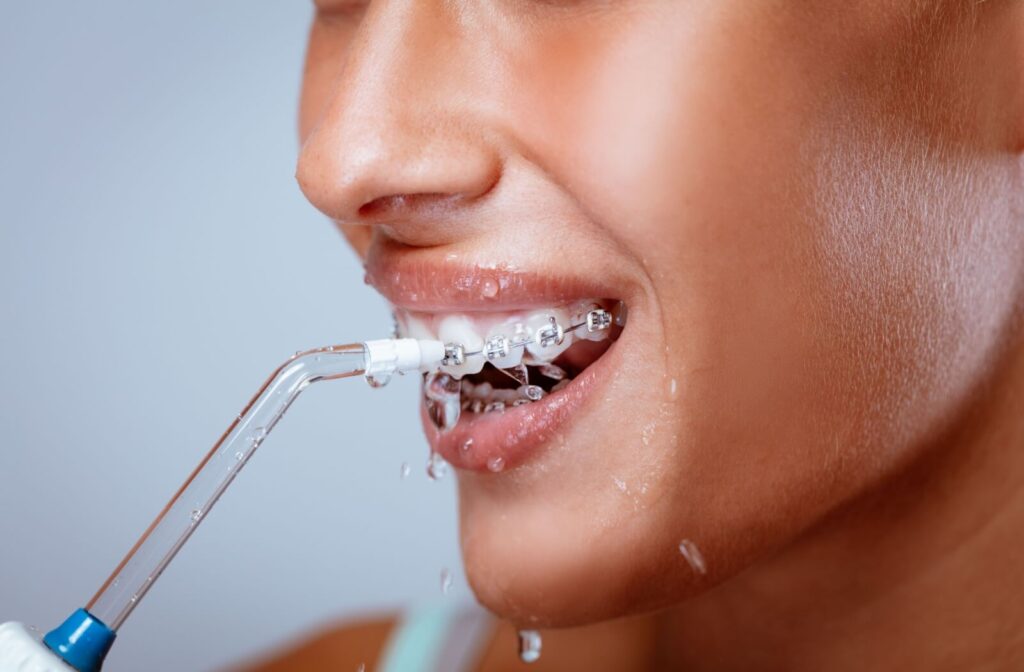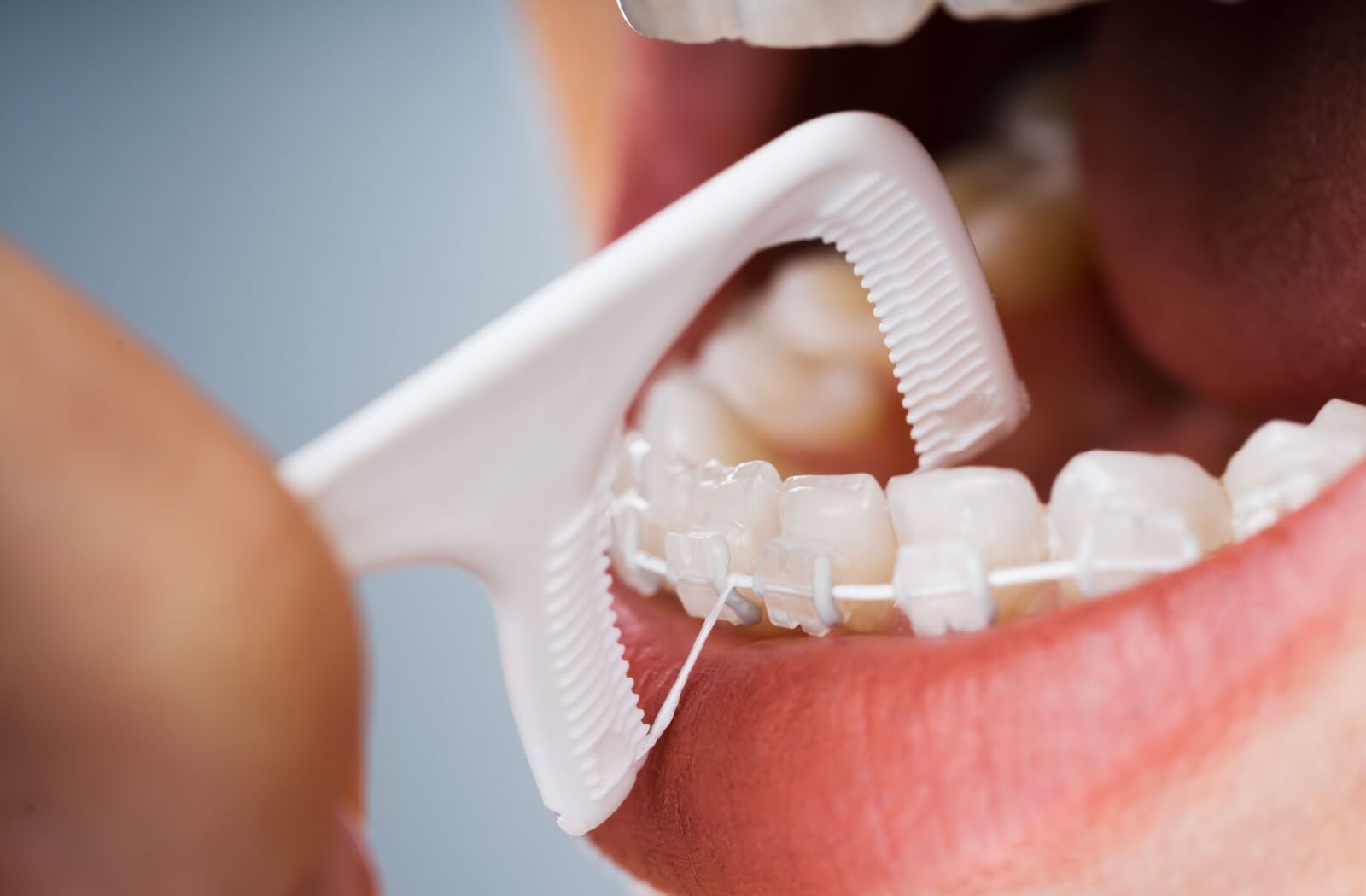Your braces are paving the way for a straighter, healthier smile. Among all the steps in your hygiene routine, flossing might seem the trickiest, but it doesn’t have to be! Flossing with braces can become second nature with the right tools, techniques, and a little practice.
When flossing with braces, use the flossing tool of your choice to curve the floss in a “C” shape around each tooth. You can use a floss threader to help pull the floss underneath your braces to clean deeper. You can also use a water flosser if needed.
Why Flossing with Braces Is Critical
Brushing your teeth is essential for removing bacteria and preventing plaque buildup. However, your toothbrush can’t reach every nook and cranny. Flossing helps remove food particles and debris from between your teeth and along the gum line, protecting you from:
- Tooth decay
- Food left between teeth feeds harmful bacteria & weakens enamel
- Gum disease
- Plaque buildup along the gumline leads to inflammation, irritation, & periodontitis
- Bad breath
- Stubborn food particles trapped in your braces can cause persistent bad odours
Braces add an extra layer of complexity, with brackets and wires creating more places for plaque to hide. Flossing becomes even more crucial for maintaining oral health throughout your orthodontic journey.
Tools for Flossing with Braces
Using the right tools can make flossing with braces much easier and more effective.
Choose the tool that works best for your comfort and routine. Many people find that combining traditional floss with a water flosser hits the sweet spot for hygiene.
Here are some popular options.
Floss Threaders
Floss threaders use a small, flexible loop that helps guide regular floss underneath wires. They allow you to access the gum line and hard-to-reach areas more easily.
Water Flossers
Water flossers, oral irrigators, or dental water jets use a steady water stream to help remove food and plaque stuck between teeth and around brackets.
It can take practice to use effectively, but water flossers can help reach tricky spots, especially for those who find traditional flossing challenging. While Waterpik is a well-known brand name, most water flossers offer similar results.
Dental Tape
Dental tape is a wider, flat type of floss that can feel gentler on sensitive gums. It’s ideal for those new to flossing or with inflamed gums.
Step-by-Step Guide to Flossing with Braces
Flossing with braces can require patience, but the process is straightforward once you get the hang of it. Follow these steps to help you floss like a pro.
1. Prepare Your Floss
Cut about 18 to 24 inches of floss. You’ll need enough to wrap securely around your fingers and use a fresh section for each tooth.
2. Thread the Floss
Use a floss threader to guide the floss beneath the wire of your braces. Once through, hold the floss tightly with both hands.
3. Clean Between Your Teeth
Curve the floss into a “C” shape around each tooth, gently moving in a circular motion up and down along the tooth surface and under the gum line. Avoid snapping the floss, as it can damage your braces or hurt your gums.
4. Move to the Next Tooth
Carefully slide the floss from underneath the wire and move to a clean section for the next tooth. Repeat until you’ve flossed between and around the sides of every tooth.
5. Double-Check Hard-to-Reach Areas
Make sure you floss the molars at the back of your mouth, as these areas are especially prone to plaque buildup.
Flossing with a Water Flosser

If traditional flossing feels cumbersome, a water flosser is an excellent alternative for cleaning around braces. Here’s how to use one:
- Fill the reservoir. Use warm water to prevent sensitivity.
- Attach the orthodontic tip. The tip is specifically designed to clean around brackets and wires.
- Set the pressure. Start at the lowest setting and gradually increase to a comfortable level.
- Lean over the sink and turn on the device. Aim at the gumline and keep your mouth slightly open to allow water to flow out.
- Follow the gum line. Trace along the gum line and around each bracket, covering all sides of your teeth.
- Repeat as needed. Water flossers can remove a lot of debris, but complementing their use with traditional floss can support thorough cleaning.
Troubleshooting Common Challenges
Flossing with braces can come with its own set of obstacles. Here’s how to overcome some common issues.
Struggling to thread floss under wires? Use a floss threader or pre-threaded floss made for braces.
Are sensitive gums causing discomfort while flossing? Try dental tape or a water flosser for a gentler approach. Your gums will become less sensitive with consistent flossing.
Do you notice you’re missing spots at the back of your mouth? Use a mirror to confirm you’re hitting every tooth, or ask your dentist or orthodontist for additional tips.
Do you run out of time to floss daily? Incorporate water flossing as a quicker alternative or floss at night when you’re less rushed.
Make Flossing with Braces a Habit
While it may feel like a hassle at first, flossing with braces is a vital step in achieving a radiant, healthy smile. The time and effort you invest now will pay off by preventing dental issues and making your braces more effective in the long run.
When you have questions about your flossing technique or want to explore tools like water flossers further, the team at Orthodontic Smile Studio is here to help! Call us today to schedule an appointment and take the next step toward a healthy smile.



